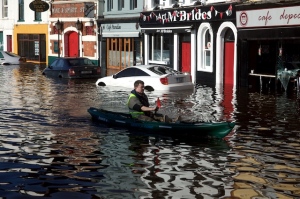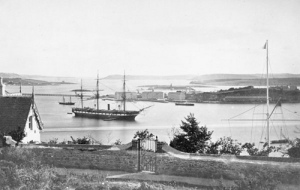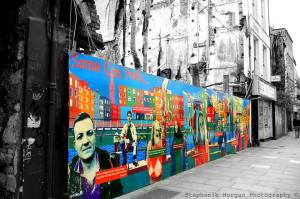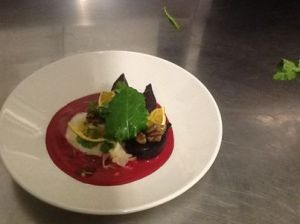Cork City – Watery Gateway to the World
English Queen Visits English Market.

As well as shaking hands with former IRA Commandant Martin McGuinness, Queen Elizabeth II, took time on her trip to Ireland to visit Cork’s English Market in May 2011. She was impressed by the fact that the market victualled British troops, right back to the Napoleonic Wars. The cornucopia known as the English Market, a roofed food market that has been trading since 1788, is my favourite place in Cork city.

Like Cork City and the Irish economy, the English Market has survived, sometimes only barely, through good times and bad. In January 1789, the market closed when serious flooding put the entire city under water. The English Market remained open throughout the famine years (the starving kept at bay by a special constabulary unit). The Market miraculously survived the burning of the city by the British in December 1920. It has endured fires and attempts replace it with a car park. The arrival of thousands of immigrants to the city has enriched Cork life and the market reflects this. The ‘foodie’ middle class can choose from an infinite variety of olives, foccacia breads and organic meats. Under the same roof, the old working class continues to buy cheap cuts of meat.
Global City
Cork has long been a globalised sort of place. It, and Cobh (the Cove of Cork), was a departure point for people leaving Ireland to change the world and a reception point for receiving people wanting to change their own lives for the better. Thousands of famine-stricken migrants left Ireland from Cobh in the 1840s. The Titanic made its last stop in Cork harbour. Hundreds of the passengers of the liner Lusitania, whose sinking in 1915 by a German U-Boat brought the US into the First World War.
Survivors from the Lusitania were brought to the hotel now known as The Commodore.
To cash in on the tourist trade, one Cobh publican changed the name of his establishment from O’Leary’s to the Lusitania. His rival next door changed the name of his pub from The Rotunda to The U-Boat.
A Wet and Marshy Place

The name ‘Cork’ means marshy place and refers to the fact that the centre of Cork City is built on islands, surrounded by the River Lee. The river channels between the marshes were infilled to form St Patrick’s Street, the Grand Parade, Henry Street, Grattan Street, Cornmarket Street, Sheare’s Street. Recent pictures show St Patrick’s Street looking like Venice. Global warming may eventually drown Cork.
English people used to call my father (born in Cobh when it was called Queenstown) “Geordie” because there is a similar Scandinavian lilt to the accents of Cork and Newcastle-upon-Tyne. In the sixth century, St Finbarre founded a monastery, which was the beginning of the city. Cork experienced its first recorded encounter with the Vikings in 820, when they attacked Finbarre’s great monastery. The Vikings and the monastic community eventually arrived at a form of peaceful coexistence. The seafaring and trading abilities of the Vikings proved to be a boon to the monastery and they established Cork as an important trading centre.

The Anglo-Normans first came to Cork in 1172 and changed the look of the city by building city walls and churches. The city still has a continental kind of atmosphere although most of the medieval buildings have disappeared and the fabric of today’s Cork dates mainly from the 18th and 19th centuries. It did not help that the thuggish Black and Tans set fire to the city in 1920 as a reprisal.

Like New Orleans, Cork has its French Quarter around French Church Street and Carey’s Lane. Many Huguenots left France when the Edict of Nantes, which had granted religious freedom to Protestants, was revoked in 1685. Despite their small numbers, the Huguenots became prominent in the commercial and civic life of the city. Many Huguenots served as Sheriffs and Mayors of Cork.

Guns and Butter, Boom and Bust

Although it was a hotbed of rebel activity, Cork did well out of the British Empire. Haulbowline Island in Cork Harbour was a major British naval base and defence against Napoleon. Cork exported salted beef, pork and butter to the West Indies and fed the British navy. The unrivalled ability of Cork Harbour to shelter the biggest fleets assembled during the American War of Independence and, later, during the Napoleonic Wars was a major factor in the expansion of the provisions trade in Cork.

I remember when Cork was dirt poor. Ancient black- shawled women, like one might see in Greece, Sicily or Portugal, moved like shadows in the warrens of alleyways that climbed the steep streets. Beggars sat on St Patrick’s Bridge.
Henry Ford’s grandfather was a Corkman from Ballinascarthy, who, in 1847, at the height of the Famine, made the gruelling voyage from Queenstown (Cobh) to Quebec. The Cork factory was its Ford’s oldest (established in 1917) outside the US. It closed in 1984 as did the Dunlop tyre factory, resulting in a loss of 2,500 jobs. The Dutch-owned Verolme shipyard at Rushbrooke gave up shipbuilding in 1985. At its prime, the yard employed more than 1,200 people working in shipbuilding, ship-repair, offshore platform modules and many other engineering enterprises.
Viagra Boom
In the 1990s, new industries came to Cork. Cork City became one of Ireland’s most important IT hubs. Low corporation tax attracted multinationals like Apple and Amazon. Pfizer manufactures Viagra in Cork. Many multinational pharmaceutical companies are located in Little Island. Cork is now Ireland’s most important centre for the chemical industry and Ireland’s only oil refinery is located at Whitegate across the harbour from Cobh.
Tourism
Cork was European Capital of Culture in 2005.
Murphy’s Brewery at Lady’s Well
The Cork International Jazz Festival has played host to everyone who is anyone in the jazz business. Guinness sponsor the Jazz Festival, although Murphy’s brewed at the Lady’s Well brewery in Cork is a far superior drink. The festival takes place at the end of October , just as the department stores are putting on their Christmas display. The Cork International Film Festival was established in 1956 and is still going strong every November.

Almost 100,000 passengers arrive in Cobh each year when large cruise liners berth right in the centre of the town at Ireland’s only dedicated cruise terminal. Tourist attractions are focused on the maritime and emigration legacy of the town and include the Queenstown Story Heritage Centre, Titanic Experience, Titanic Trail walking tour, and St Colman’s Cathedral.
The town has remained largely unchanged since the Titanic departed from Cork Harbour in 1912, with the streetscape and piers still much the same. There is evidence of the greed years of the property bubble in that the spacious gardens of the grand houses on Lake Road have been subdivided and built on.
Hope for the Future?
According to the IDA (Irish Development authority), Cork is the industrial heart of Ireland. Dublin as a region had the lowest proportion of Irish-owned industrial units in 2011 at 14.5%. The south-west region, with a much smaller population, accounted for 15% of Irish-owned industry. Average industrial wages in the Cork region are €44,800, while the Dublin region is next highest at €44,700.

The English Market is a good symbol for Cork, encapsulating the political, socio-economic, cultural and dietary history of the city across 226 years. The first surge in economic growth in the 1960s led to a more open and adventurous outlook and significant changes in patterns of food buying and eating.
The Paradiso- my favourite restaurant in the entire universe
Ireland used to be a gourmet hell but now Cork has celebrity chefs and fine restaurants. In the 1990s, influences from abroad were absorbed.
The English Market still thrives despite the economic downturn. English Market produce left unsold goes to the homeless. Homeless people have been known to ask ABC (the Alternative Bread Company) “Do you have any of that rosemary focaccia?”













